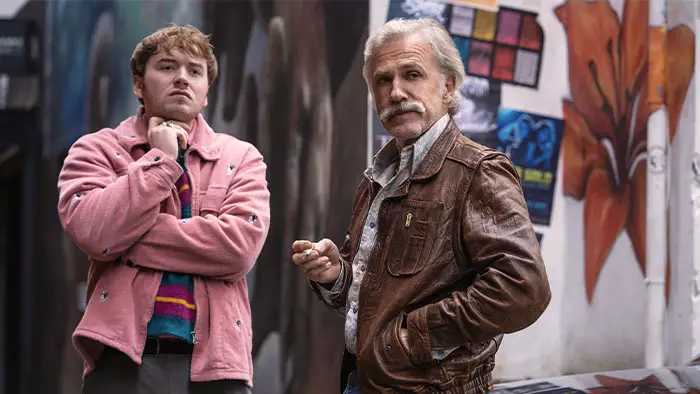
Inevitably, any decade-ending period gives rise to a retrospective of the finest cinematic input from the previous ten-year span. Certain films obviously rise to the top, while a mix of eccentric and eclectic (yet well-known) choices pepper the selection.
But due to the various inanities of the film industry in general and film distribution in particular, many fine films never received the wide level of theatrical and home video release which they were due. Subsequently, many of these films went unseen by the influential media outlets who can make or break a film…not to mention the public whose input ultimately decided which film rocks the box-office and which lies in the proverbial dust.
While other critics sing “Hosanna” to the likes of “Pulp Fiction,” “Schindler’s List” and “American Beauty,” I’d like to say a kind word (indeed, a very rare word) for some entertaining, challenging flicks which never quite found their way to mainstream audiences. These films are, in my mind, the 10 best 90s films you never saw!
1. “Begotten” (1991). Elias Merhige served up a jolting experimental tour-de-force with this 75-minute work of mad art. Told without dialogue, this unique production offers a warped Passion Play in which a lonely god disembowels himself, only to be replaced by a lithe goddess who rises from his bloody remains. She gives birth to a quivering man-child who is first revered, but then destroyed by a tribe of hooded figures. “Begotten” offered a rare visual treat: it was shot on reverse stock film, then reshot of standard film frame-by-frame and using a variety of different filters. Married to that is a soundtrack of howling winds, chirping birds and hushing breezes and the film which emerges is a masterpiece of surreal imagination run amok. “Begotten” only received a scant self-distribution by the filmmaker and is on video from World Artists. Director Merhige, however, is currently at work on a biopic about German silent film star Max Schreck, starring Willem Dafoe.
2. “Sicario” (1995). Venezuela’s tiny film industry produced this devastating tale of a slum teenager who rises too quickly within that nation’s drug cartel. “Sicario” mirrors “Los Olvidados” with its unflinching depiction of street youth, but the film goes Bunuel one further with a gritty violence and unapologetic celebration of thuggery which is as hypnotic as it is terrifying. “Sicario” was the Venezuelan entry for the Best Foreign Film Oscar competition, but it did not get a nomination and was only seen in a handful of film festivals (some distributors vetoed the film’s grisly prison rape sequence for not picking up the rights for US release). At last check, it was not on home video.
3. “Plan 10 from Outer Space” (1994). No, this has nothing to do with Ed Wood. Utah filmmaker Trent Harris created this riotous Mormon-inspired comedy in which a plucky young writer uncovers evidence that one of Brigham Young’s many wives was actually an extra-terrestrial. This otherworldly wife returns in the form of Karen Black, who camps it up wonderfully (and even sings a Mormon hymn with off-key fervor) while plotting world domination. Having a knowledge of Mormon theology and history is helpful to understanding much of the humor, which may explain why the film had very few theatrical engagements beyond Salt Lake City. The film was released on home video by Leo Films.
4. “The Closest Thing to Heaven” (1995). North Carolina filmmaker Dorne Pentes created this charming Altmanesque comedy which presents five tales of down-on-their-luck people on the worst day of their respective lives. The film is completely fresh in its story lines and its off-center humor–most memorably the tales of the hot-to-trot stud who somehow gets reined into domestic respectability by a too-serious single mother and the drunken good ol’ boy who discovers his African-American wife is having an affair, unaware that the object of her affection is the black preacher in whom he confides. The failure of “The Closest Thing to Heaven” to break into the mainstream (it played the festival circuit and briefly ran in Los Angeles before its World Artists home video release) is one of the more unfortunate happenings of the 90s.
5. “Dika: Murder City” (1994). Michæl D. Moore’s documentary on 74-year-old punk rock singer Dika Newlin is not, by any stretch, a brilliantly made film. Perhaps some more care may have gone into the camerawork (a tripod and light meter would have been nice). But the film’s production flaws are easily overlooked by the mad genius of Dika Newlin, a woman who presents the facade of sincerity and intelligence during conversation but who turns into a raving maniac whenever she steps before a microphone while the music plays. Dika’s singing style resembles the illegitimate vocal mating of Audrey Meadows’ Alice Kramden from “The Honeymooners” and Burgess Meredith’s Penguin from “Batman,” and the sight of this wacky septuagenarian tearing into a garage-rock rendition of “These Boots Were Made for Walking” while clad in black leather offers the unlikeliest musical highlight of the 90s. “Dika: Murder City” won several awards on the festival circuit before going into a Moore Video release; the film can be viewed for free on The Sync (www.thesync.com) web site.
6. “Silent Witness” (1996). The 90s has seen a surplus of documentaries on the tragedy of the Holocaust. Strangely, the best film of this genre was barely seen: this Canadian documentary which detailed the care and hard work which goes into preserving the death camps for future generations to visit and learn from the horrors of the 1940s. Much like Claude Lanzmann’s epic “Shoah,” “Silent Witness” eschewed historic footage and allowed those who survived and the succeeding generations speak from their own viewpoints of what transpired and what can be done so the memory of the lost never vanishes. “Silent Witness” had a shadowy distribution and, as of this writing, is not available on home video.
7. “Guelwaar” (1991). Senegalese director Ousamane Sembene is widely considered the father of modern African cinema, yet his reputation among American audiences is severely limited to those who seek out African films. “Guelwaar” is perhaps the finest work of his career: a leisurely comedy of manners and clashing cultures which quietly erupts when a Christian man is accidentally buried in a Muslim cemetery. “Guelwaar” offers a rare and trenchant examination of contemporary culture in Senegal, dissecting that nation’s gender and theological disputes while attempting to reconcile the omnipresent notion that one-time colonial power France offers a better way for Africans seeking the Western concept of the good life. “Guelwaar” had a brief theatrical release via New Yorker Films and an equally quick life on home video.
8. “Lily in Limbo” (1998). During the 1990s, short films enjoyed a healthy revival and found new outlets for presentation via cable television and the Internet. The best of this genre comes from Berkeley-based Antero Alli, who has developed a devoted cult following for his challenging and often cryptic feature films (“Archaic Community,” “The Drivetime”). “Lily in Limbo” presents Alli’s finest film to date, with a one-woman tour-de-force by Sylvie Pickering as an artist whose self-imposed isolation corrupts her senses into a state of bitterness and delusion. In her solitude, she loses herself in a series of bizarre dreams thick with haunting images and disturbing sounds (Ms. Pickering created the film’s quirky score), while the unlikely delivery of a curious birthday gift disrupts her comfortable world. A fascinating essay of a lost soul who is uncertain whether rescue is something she really wants, “Lily in Limbo” played briefly in a number of festival and is available on home video from ParaTheatrical ReSearch.
9. “Strangers in Good Company” (1991). Originally titled “In the Company of Strangers,” this small but delightful Canadian film provides a pleasant diversion into the lives of the most wonderful ladies imaginable. The plot is slender–a group of elderly tourists are stranded in an isolated lodge–but the film avoids all of the most obvious cliches by opening up into the worlds of the women who come to make the best of their situation. The elderly cast were non-professional actresses and the stories which they highlight were based on their own experiences: a spunky British woman who recalls the wartime blitz, a self-assured lesbian who came to terms with her sexuality, a nun who found the holy within the profane world, etc. Perhaps the film was too gentle or fey to enjoy a proper theatrical release, as it came and went far too quickly. However, Touchstone Pictures recently re-released “Strangers in Good Company” on home video, thus providing it with the proper chance to find its audience.
10. “Highway of Heartache” (1996). Billed as the world’s first country-music drag queen movie musical, “Highway of Heartache” dived heavily into the twin pools of John Waters grotesquery and Nashville rhinestones and emerged as the wackiest parody of all things soapy. Director Greg Wild invented a cartoonish environment (complete with Day-Glo sets and costumes) which found the much-harried Wynona Sue Turnpike longing for superstardom in Opryland. After dispatching her trailer-trash husband (and pausing to sing his demise with “I’ve Got a Ring on My Finger and a Stiff on My Hands”), Wynona and her hefty drag queen guardian angels (played by the Big Wigs) embark on a raucous ride through the lands of venereal disease, dark secrets brought to light, recording music glamour and life behind bars. A batty and brilliant effort which out-Sirked Douglas Sirk in its extreme twists and turns, “Highway of Heartache” was barely seen in its very brief self-distribution and has yet to snag a home video release.
Check out FILMTHREAT.com’s FEATURE ARCHIVES and read more insightful stories, expert analysis, gut-busting satire and caustic commentary!

